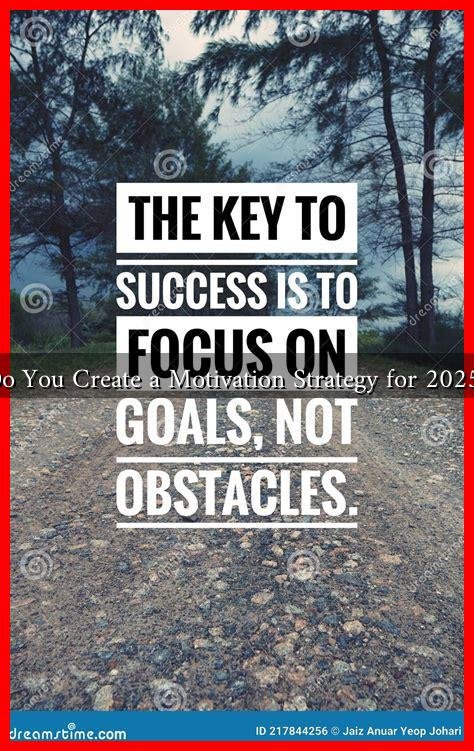-
Table of Contents
- How Do You Create a Motivation Strategy for 2025 Goals?
- Understanding Motivation: The Foundation of Your Strategy
- Setting Clear and Achievable Goals
- Identifying Your Sources of Motivation
- Creating an Action Plan
- Leveraging Technology for Motivation
- Case Studies: Successful Motivation Strategies
- Conclusion: The Path to Achieving Your 2025 Goals
How Do You Create a Motivation Strategy for 2025 Goals?
As we approach 2025, setting and achieving goals becomes increasingly important for both individuals and organizations. A well-defined motivation strategy can be the key to unlocking potential and driving success. This article will explore how to create an effective motivation strategy tailored to your 2025 goals, incorporating research-backed techniques, real-world examples, and actionable steps.
Understanding Motivation: The Foundation of Your Strategy
Before diving into the specifics of creating a motivation strategy, it’s essential to understand what motivation is and why it matters. Motivation can be defined as the process that initiates, guides, and maintains goal-oriented behaviors. According to a study published in the *Journal of Applied Psychology*, motivated individuals are more likely to achieve their goals and experience higher levels of satisfaction in their personal and professional lives.
Setting Clear and Achievable Goals
The first step in creating a motivation strategy is to set clear and achievable goals. The SMART criteria—Specific, Measurable, Achievable, Relevant, and Time-bound—can be a useful framework for this process.
- Specific: Define your goals clearly. Instead of saying, “I want to get fit,” specify, “I want to run a 5K in under 30 minutes.”
- Measurable: Establish criteria for measuring progress. For example, track your running times weekly.
- Achievable: Ensure your goals are realistic. If you’re new to running, aiming for a marathon in three months may not be feasible.
- Relevant: Align your goals with your broader life objectives. If health is a priority, then fitness goals are relevant.
- Time-bound: Set deadlines to create urgency. For instance, aim to complete your 5K by June 2025.
Identifying Your Sources of Motivation
Understanding what motivates you or your team is crucial for developing a successful strategy. Motivation can stem from various sources, including:
- Intrinsic Motivation: This comes from within, driven by personal satisfaction or the joy of completing a task.
- Extrinsic Motivation: This involves external rewards, such as bonuses, recognition, or promotions.
- Social Motivation: The desire to connect with others and be part of a community can also drive motivation.
Conducting surveys or interviews can help identify these sources. For example, Google uses employee feedback to tailor its motivation strategies, resulting in higher employee satisfaction and productivity.
Creating an Action Plan
Once you have set your goals and identified your sources of motivation, the next step is to create an action plan. This plan should outline the specific steps you will take to achieve your goals. Consider the following components:
- Break Down Goals: Divide larger goals into smaller, manageable tasks.
- Set Milestones: Establish checkpoints to assess progress and make adjustments as needed.
- Accountability: Share your goals with a friend or colleague who can help keep you accountable.
- Celebrate Successes: Recognize and reward yourself for achieving milestones to maintain motivation.
Leveraging Technology for Motivation
In today’s digital age, technology can play a significant role in enhancing motivation. Tools like productivity apps, goal-tracking software, and online communities can provide support and encouragement. For instance, platforms like Trello or Asana can help you organize tasks and visualize progress, while fitness apps like Strava can connect you with a community of like-minded individuals.
Case Studies: Successful Motivation Strategies
Several organizations have successfully implemented motivation strategies that can serve as inspiration:
- Salesforce: The company uses gamification techniques to motivate its sales team, incorporating leaderboards and rewards for top performers.
- Netflix: By fostering a culture of freedom and responsibility, Netflix motivates employees to take ownership of their work, leading to higher engagement and innovation.
Conclusion: The Path to Achieving Your 2025 Goals
Creating a motivation strategy for your 2025 goals involves setting clear objectives, understanding your sources of motivation, developing an actionable plan, and leveraging technology. By following these steps and learning from successful case studies, you can enhance your motivation and increase your chances of achieving your goals. Remember, motivation is not a one-time effort but a continuous process that requires regular reflection and adjustment. As you embark on this journey, keep in mind that the path to success is often as important as the destination itself.
For more insights on motivation strategies, consider exploring resources from the American Psychological Association at apa.org.


